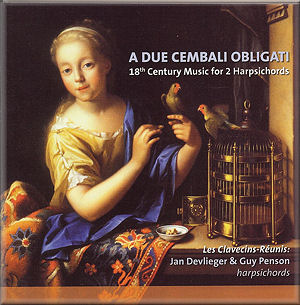 |
 |
|


alternatively
CD:
AmazonUK
AmazonUS
|
A due cembali obligati - 18th Century Music for
Two Harpsichords
Christoph SCHAFFRATH
(1709-1763)
Duetto in a minor [11:45]
Gaspard LE ROUX (?-1705/07)
Suite No 1 in d minor [10:21]
Johann Sebastian BACH
(1685-1750)
Kunst der Fuge (BWV 1080):
Contrapunctus 13 rectus & Contrapunctus 13 inversus [05:03]
François COUPERIN
(1668-1733)
9e Ordre in A:
Allemande à deux clavecins [04:10]
15e Ordre in a minor:
Muséte de Choisi & Taverni [04:06]
Carl Philipp Emanuel BACH
(1714-1788)
Four Duets (Wq 115 / H 610-613) [10:04]
Johann Christian BACH
(1735-1782)
Sonata a due cembali obligati in G (Warb A 21) [08:33]
Antonio SOLER (1729-1783)
Concierto III in G [08:33]
 Les Clavecins Réunis (Jan Devlieger, Guy Penson, harpsichord)
Les Clavecins Réunis (Jan Devlieger, Guy Penson, harpsichord)
rec. 27 - 30 December 2008, Library of Muziekcentrum De Bijloke,
Ghent, Belgium. DDD
 ET'CETERA KTC 1392 [62:39]
ET'CETERA KTC 1392 [62:39] 
|
|
|
In the late 18th century the playing of keyboard duets was a popular pursuit, especially in bourgeoisie circles. It was most practical to play with four hands on one keyboard, and that is the pattern followed by most keyboard duets. Very few people will have had two keyboards available, so it is assumed that where the composer opted for this the duets were mostly played in public concerts.
The first keyboard duets seem to have been composed in England in the early 17th century. In New Grove a composition by Giles Farnaby (c.1563-1640) is mentioned as the earliest piece for two keyboards. But the repertoire from the 17th century is very small. An important contribution to the genre came from Bernardo Pasquini, who published a series of 14 sonatas for two harpsichords in 1704. He gave only the bass lines which have to be worked out like a basso continuo part by the players.
Other early examples of music for two keyboards are from France. Gaspard Le Roux is a composer about whom we know very little. His 'Pièces de clavecin' were published as music for one harpsichord, but the composer himself stated that most pieces had their full effect only when played on two keyboards. For some pieces a complete score for a second harpsichord is included. François Couperin wrote his four books of 'Pièces de clavecin' also for solo harpsichord, but some pieces require a different scoring, such as harpsichord and violin or viola da gamba. Two pieces are for two harpsichords; the second played here is 'Musette de Choisi & Taverni' which is in the style of folk music.
In Germany Johann Sebastian Bach was one of the first to write music for two keyboards. His Concerto for two keyboards and strings in C (BWV 1061) was originally written without accompaniment. Here we hear two famous pieces which belong to his Kunst der Fuge. His sons also composed for this scoring. One of the best-known is the Concerto a due Cembali by his eldest son Wilhelm Friedemann. On this disc we get four duets by his second son, Carl Philipp Emanuel. The dynamic contrasts the composer included in these pieces point in the direction of the fortepiano, but they are also playable on harpsichords with two manuals.
These four duets reflect the style of the Empfindsamkeit, and so does the Duet in a minor by Christoph Schaffrath, who was harpsichordist at the court of Frederick the Great of Prussia, and was appointed harpsichordist to the king's sister Amalia in 1741. The duet played here is one of the two Schaffrath wrote. The Sonata in G by Johann Christian Bach, Johann Sebastian's youngest son, is rather different, and of a more diverting character.
The last item is from Spain. Antonio Soler was a pupil of Domenico Scarlatti and his keyboard sonatas bear the traces of his teacher's style. Remarkable in his oeuvre are the six concertos for two organs - at least, that is what the title says. But in the liner-notes Jan Devlieger argues that the range of the keyboard parts extend beyond that of the organs of El Escorial. Here the royal family regularly resided, and it was for crown prince Gabriel Bourbon that Soler composed these concertos. They have been recorded on organs, harpsichords and even fortepianos before, and, historically at least, the former two are most plausible. The Concierto III is one of the most virtuosic, in particular the second movement.
Recordings with music for two harpsichords have been made before, but on this disc the most obvious pieces have been ignored. It includes some lesser-known works instead, in particular the duets by Schaffrath and Johann Christian Bach. Of the four duets by Carl Philipp Emanuel Bach I recognized only the last. And Le Roux isn't a household name either. So from that perspective there is every reason to welcome this disc.
The performances are additional reasons to commend this recording. Jan Devlieger and Guy Penson give very fine and lively interpretations, and these have been splendidly recorded. One piece of advice: turn down the volume control of your equipment and in particular your headphones, otherwise you could damage your ears (or annoy the neighbours), as the volume of the recording is very high. There is a strong division between the two channels in this recording: one harpsichord on the left, the other on the right. With this kind of repertoire that is absolutely right.
Another merit of this disc is the use of three different pairs of harpsichords: two Flemish single manual instruments after Ruckers with 'ravelment' (an extension of the instrument according to the fashion of the 18th century), two double-manual French harpsichords after Collesse, and two single manual Portuguese instruments after Antunes.
In short: great stuff for every lover of the historical keyboard.
Johan van Veen
|
|

